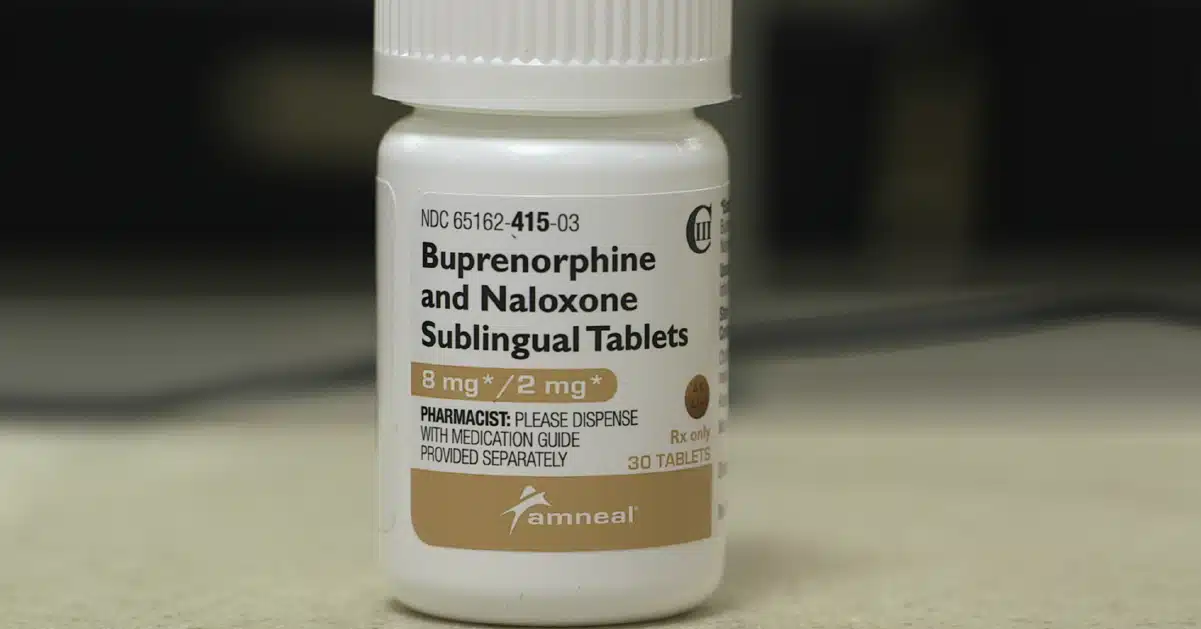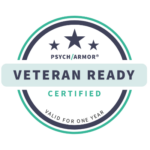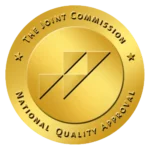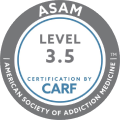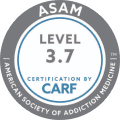Suboxone is a cure used to treat opioid dependence. It’s prescribed to help people reduce or quit opioid use.
This medication aids in opioid addiction recovery by managing withdrawal, reducing cravings, and supporting individuals on their journey to a drug-free life.
Key Takeaways
Suboxone is a medication vital in overcoming opioid addiction. Here’s what you need to know:
- The components of Suboxone include buprenorphine, a partial opioid agonist, and naloxone, an opioid antagonist, to prevent misuse.
- Suboxone comes in different formulations, such as sublingual film and tablet, with varying ratios of buprenorphine to naloxone for tailored treatment plans.
- Proper administration involves placing the film or tablet under the tongue, avoiding food and drink for optimal absorption, and following the prescribed schedule.
- Addressing myths about Suboxone, it is not just another addictive drug; it aids in managing a medical condition, minimizing withdrawal symptoms, and providing a bridge to stability.
The Haven Detox-South Florida provides a compassionate and comprehensive recovery experience from addiction. Call us at (561) 328-8627 and get a path of recovery with personalized care and support.
What is Suboxone
Suboxone is a medication used to help individuals overcome opioid addiction. It combines two key ingredients: buprenorphine and naloxone. Buprenorphine eases the discomfort of opioid withdrawal and cravings, acting on the same receptors as opioids but with a milder effect. Naloxone is included to prevent misuse. If someone tries to inject Suboxone, it triggers withdrawal symptoms.
Typically taken by dissolving under the tongue, Suboxone helps people gradually reduce or quit opioid use. It’s a crucial part of medication-assisted treatment (MAT), a comprehensive approach involving counseling and support.
Suboxone helps manage withdrawal symptoms and cravings, supporting recovery toward a drug-free life. It’s essential to use Suboxone as prescribed under medical supervision to maximize its effectiveness and safety.
Components and Types of Suboxone
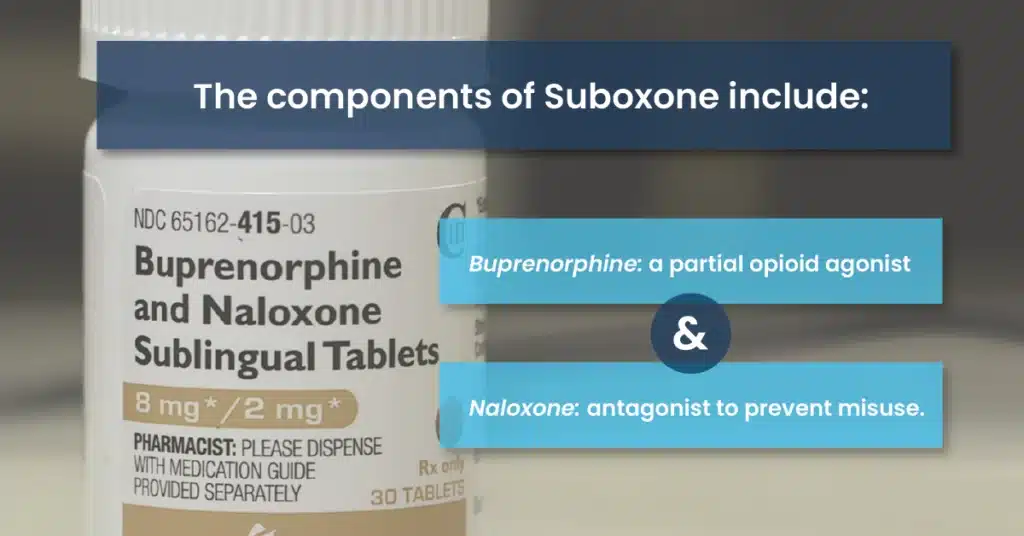
Suboxone, a medication aiding in opioid addiction treatment, consists of two primary components: buprenorphine and naloxone.
Buprenorphine: This component is a partial opioid agonist, meaning it ties to the same receptors as opioids but with a milder effect. It helps manage withdrawal symptoms and cravings, supporting a smoother transition away from opioid use.
Naloxone: Naloxone is an opioid antagonist included to prevent the abuse of opioids. If someone attempts to inject Suboxone, naloxone triggers rapid opioid withdrawal. It discourages improper use and promotes safer administration.
Suboxone comes in different formulations:
- Sublingual Film: A sublingual strip is placed under the tongue and gradually dissolves to release the medication.
- Sublingual Tablet: Similar to the film, it dissolves under the tongue, allowing for efficient absorption.
- Combination Ratios: Suboxone may vary in the ratio of buprenorphine to naloxone. Common ratios include 2mg/0.5mg, 8 mg/2 mg, and others, allowing for tailored treatment plans.
These different forms and ratios provide flexibility in addressing individual needs within a comprehensive treatment approach, including counseling and support, promoting a successful journey toward recovery. It is crucial to follow medical guidance for the safe and effective use of Suboxone.
The Role of Suboxone in Opioid Withdrawal
In the challenging journey of overcoming opioid addiction, Suboxone emerges as a crucial ally. This medication stands at the forefront of support during opioid withdrawal. Let’s delve into its pivotal role and understand how Suboxone becomes a lifeline in pursuing recovery. Here’s the breakdown:
Buprenorphine’s Role: Buprenorphine attaches to opioid receptors, reducing withdrawal symptoms. It’s a partial opioid agonist, meaning it provides relief without inducing the intense high associated with opioids.
Naloxone’s Safeguard: Naloxone, an opioid antagonist, prevents misuse by discouraging injection. When taken as prescribed, naloxone stays inactive, ensuring safe use.
Withdrawal Symptom Alleviation: Suboxone lessens cravings and withdrawal discomfort, fostering a smoother recovery process. It helps individuals regain stability without the overpowering effects of opioids.
Suboxone is a cornerstone in medically assisted detox, providing a safer transition. Its controlled dosage minimizes the risk of severe withdrawal reactions.
Suboxone supports a gradual reduction of opioid dependence, enabling individuals to focus on recovery. It’s a tool that promotes sustainable progress in the journey to sobriety.
Suboxone is often part of a comprehensive treatment plan, combining medication with counseling and support. This holistic approach addresses both the physical and psychological aspects of addiction.
Suboxone stands as a valuable resource in combating the opioid crisis. Its dual-action mechanism provides a bridge to recovery, allowing individuals to navigate withdrawal with increased comfort and security.
Administration of Suboxone: Dosage and Frequency
The road to recovery from opioid dependence requires understanding the proper administration of Suboxone. Let’s delve into the crucial aspects of Suboxone dosage.
Starting Point: Begin with a healthcare provider-prescribed dose based on your opioid use history. Initial doses are often lower, gradually adjusting to find the most effective level.
Regular Monitoring: Medical professionals closely monitor your response to Suboxone. Dosage adjustments may occur to optimize the medication’s effectiveness.
Steady Progress: The goal is to reach a stable maintenance dose that curbs cravings and withdrawal symptoms. A consistent, manageable dosage fosters a smoother recovery journey.
The full potential of Suboxone in your recovery journey involves knowing the correct way to take this medication. When taking medication in the form of a film or tablet, it is essential to understand the optimal method of administration under the tongue to ensure its effectiveness. Maximize Suboxone’s support in your pursuit of a life free from opioid dependence.
Sublingual Administration: Place the Suboxone film or tablet under your tongue, allowing it to dissolve completely. Avoid swallowing or chewing for optimal absorption.
Avoid Food and Drink: Refrain yourself from eating or drinking for at least 15 minutes before and after taking Suboxone. It ensures the medication is absorbed effectively.
Follow the Prescribed Schedule: Adhere to the recommended dosing schedule provided by your healthcare provider. Consistency is key for Suboxone to support your recovery effectively.
Suboxone administration is personalized, emphasizing tailored dosages and proper usage to maximize benefits in recovery.
Efficacy and Safety of Suboxone
Suboxone, a blend of buprenorphine and naloxone, is commonly prescribed for opioid use disorder (OUD) due to its efficacy and safety profile. Numerous studies support its effectiveness in reducing opioid cravings and withdrawal symptoms, contributing to improved patient outcomes.
Evidence-based outcomes of Suboxone use demonstrate its role in medication-assisted treatment (MAT), leading to higher retention rates in rehabilitation programs. Research indicates that Suboxone not only helps individuals achieve and maintain abstinence but also reduces the risk of opioid-related overdoses and mortality. The combination of buprenorphine’s partial opioid agonist properties and naloxone’s opioid antagonist effects contributes to its therapeutic success.
However, Suboxone is not without potential side effects and risks. Common side effects may include nausea, constipation, and headache. In rare cases, allergic reactions or respiratory depression may occur, stressing the importance of careful medical supervision during initiation.
Additionally, there is a risk of misuse or diversion, as Suboxone itself can be addictive. Proper patient selection, monitoring, and education are vital to mitigate these risks.
Myths about Suboxone
Suboxone, a prescription medication, often carries misconceptions. Some believe it’s just another addictive drug, but doctors prescribe it to help individuals with opioid use disorders. Suboxone contains buprenorphine, a partial agonist, reducing opioid misuse and the risk of overdose.
People worry about severe withdrawal symptoms, but Suboxone, part of a comprehensive treatment program, eases this transition. It has a ceiling effect, meaning higher doses don’t lead to more effects. Unlike heroin or other opioid medications, it offers pain relief without the same risks.
While some fear long-term use, Suboxone supports recovery with behavioral therapy and lifestyle changes. Family members play a crucial role in supporting individuals during the induction phase. In emergencies, Suboxone can help prevent opioid overdose. Though it has possible side effects, they’re outweighed by the benefits.
Addressing Suboxone Dependency Concerns
Addressing Suboxone dependency concerns involves acknowledging that, while it’s a valuable tool in opioid addiction treatment, there is a potential for dependence.
Dependency can develop if not taken as prescribed or if use continues beyond the recommended duration. It’s compulsory to follow healthcare provider guidance and promptly communicate concerns strictly.
Understanding the potential for Suboxone Abuse
Understanding the potential for Suboxone abuse is vital. Misuse may occur, especially if someone attempts to inject it. Naloxone, one of its components, triggers withdrawal if injected, discouraging improper use.
However, it’s essential to be aware of the risk and use Suboxone only as prescribed under medical supervision. Education, monitoring, and responsible usage play key roles in mitigating the potential for abuse while maximizing its benefits in aiding recovery from opioid addiction.
Frequently Asked Questions
What is Suboxone, and when should it be taken?
Suboxone is a prescription drug ratified by the Food and Drug Administration (FDA) for curing opioid addiction. It contains two main components: buprenorphine, the active ingredient, and naloxone.
Buprenorphine helps manage cravings and withdrawal symptoms, while naloxone prevents misuse. Suboxone should be taken as directed by a healthcare professional, usually under the tongue.
Disclosing all medications, including herbal remedies, is vital to avoid potential interactions. Serious side effects may occur, so promptly report any adverse reactions.
Inform your healthcare provider about a history of symptoms or head injuries. Suboxone aims to support recovery, but adherence to prescribed usage is vital for its effectiveness.
Is Suboxone the same as methadone?
No, Suboxone and methadone are different medications used in treating opioid dependence. Suboxone combines buprenorphine and naloxone, helping manage cravings and preventing misuse. It is taken under the tongue. Methadone, on the other hand, is a standalone medication that acts on opioid receptors, reducing withdrawal symptoms and cravings.
Methadone is usually administered in specialized clinics. While both aim to assist recovery, their mechanisms and administration differ. Consult a healthcare expert to determine the best option based on individual needs and circumstances. Always follow prescribed instructions for either medication and communicate any concerns promptly with your healthcare provider.
Is Suboxone a good treatment for opiate addiction?
Suboxone is a helpful treatment for opioid addiction in the United States. It contains buprenorphine and naloxone, reducing cravings and withdrawal symptoms. Taken as prescribed, it helps people regain stability. However, combining it with counseling and support is required for the best results. It’s not a cure but a tool in recovery.
Misusing Suboxone can be harmful, so following the doctor’s guidance is vital. Regular check-ins and adjustments ensure it remains effective. It’s one approach among various options, and suitability varies per individual. Overall, Suboxone can aid recovery when part of a comprehensive treatment plan.
Get Help with The Haven Detox-South Florida
If you find yourself facing Suboxone dependency, let The Haven Detox-South Florida be your guiding light. We offer various essential services to guide you through every recovery step.
Your recovery is not just a process but a finely tuned symphony of care through our Suboxone addiction treatment. We provide safe and comprehensive detoxification for a fresh start. Our residential supportive environment promotes healing and recovery.
Our advanced IV Therapy enhances your overall well-being, while SMART Recovery fosters innovative, science-based strategies for sustainable recovery.
Begin your journey toward recovery with confidence. Call us at (561) 328-8627 for more information and support.

